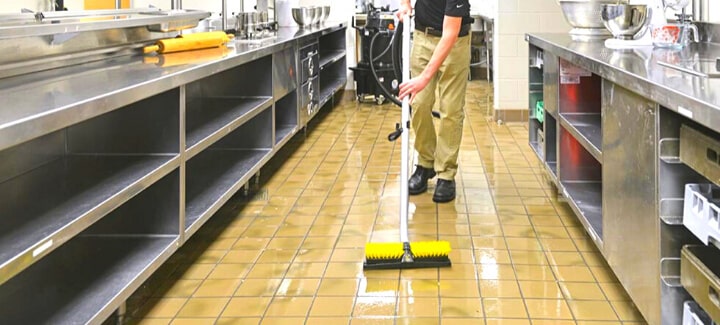
Any business which deals with food service has the critical task of keeping their food preparation areas clean. This ensures happy chefs and cooks, good hygiene standards, and above all, happy & satisfied customers served with great food. If an outlet or an organization fails to adhere to correct food safety measures, there is the likelihood of food poisoning, which may lead to health concerns for people who are consuming the food.
Clean as you go, wash hands regularly, avoid cross-contamination, maintain the right food temperature (while storing, cooking, and serving) are some of the common principles for food safety.
A business needs to follow the code set out by the state food safety department.
First, let’s concentrate on cleaning areas that can be broadly classified into three regions-
The utensil cleaning area needs to have a 3-compartment sink with dual drainboards– this is essential for washing, rinsing, and sanitizing equipment. It may further be added that the sink size should be large enough to accommodate the washing of the largest equipment used in the facility. The pressure and temperature of the water, hot and cold, should be adequate.
A separate utility sink for cleaning mops, table cloths, and towels is placed far from the food preparation area.
As per the food safety codes, the prevention of food contamination is a paramount concern. For this, it is imperative to have proper cleaning and sanitization of all contact surfaces, including utensils and equipment used for food preparation. Before reusing any equipment, ensure to wash and clean them properly. All food and equipment to be stored in a dry, clean, and moisture-free place where they are not exposed to dust or contamination. As common sense will tell us, food should not be stored near toilets, garbage rooms, or under leaky pipes, stairwells, and any other place where it could potentially be exposed to contamination. All the equipment and food surface areas should be safe, durable (non-corrosive and non-absorbent), and easy to clean. All food prep equipment such as flat-top grills and stoves should be easily movable to allow cleaning or installed to enable six-inches clearance between floor and equipment.
The establishment’s floorings should be constructed of smooth, durable materials and to be well maintained with timely repairs if required. Areas include food prep areas such as the main kitchen, walk-in refrigerators/freezers, restrooms, staff locker areas. There should be no carpeting in any place where the floor is subject to moisture like walk-in refrigerators, ware washing areas, toilet room areas, and refuse storage room. Wall and Ceiling to have smooth surfaces. All fixtures like light, vents, and fans are easily cleanable. Food prep areas and storage areas to be well lit to avoid any accidents. Food storage spaces should be handled with proper segregation of food types to prevent cross-contamination. For instance, ready-to-cook food should not be kept together with raw foods. All raw animal foods, dairy products, cold cuts, or frozen foods should be stored separately with proper temperature controls.
Recommended: Importance of Cooling Food Correctly
When kept in improper holding temperatures, food products spread germs and bacterial growth, which leads to contamination. Use thermometers to keep the temperature check and ensure that cold food holding temperatures fall under 41°F. Any food that has a temperature of 42°F and above falls in a danger zone and should be disposed of safely. Similarly, for hot food, holding temperature should not be above 135°F.
Restroom facilities should be provided for all team members. Restroom or washroom should not open directly into a food processing area. As a general safety rule, maintain a fifteen feet distance between the toilet door and the food processing area. Other areas of importance are team member lockers; these should be used only for staff changing to their work uniform, parking area to be concrete. Laundry should be managed in clean, hygienic ways to avoid contamination. Dishwashing machines to be installed in the right way. Potable water supply to be available.
The facility should have good ventilation for the prevention of grease or condensation on walls. Good, cleanable ventilation must be in place to keep the facility free from condensation, foul odors, smoke, and fumes.
Storage of bulk food should be done in bins that are clearly labeled and can be washed. All storage bins to have a secure lid.
All floors, which require water cleaning should have covered drains. Plumbing systems should be installed in a manner that there is no backflow of water. A proper sewage system should be installed to allow smooth disposal through a public sewage system.
Restaurant kitchens should follow systematic garbage disposal following the protocols as per the food safety codes provided and include separate bins for refuse, recyclables, and returnables. Containers for food waste or residue need to be durable and be easily cleaned. Food waste bins to be resistant to insects, rodents and should be leakproof.
Getting a job in a restaurant may be an easy task when you bend the rules by a bit but making the wrong kind of hire can cost you dearly when tragedy strikes in form of inspection. The state of Utah dictates that anyone working in the restaurant business and being involved in any stage of the food preparation or catering should be a certified food handler. Getting one is not a herculean task and certified institutes such as Easy Food Handlers can help you get food handlers permit by providing useful resources and guidance in the same.
Running an establishment serving food is nothing less than a battlefield during peak hours, with orders coming from all sides. Keeping your calm and ensuring that your kitchen remains clean and up to code as such crucial times requires nerves of steel but by sticking to the tips mentioned here, your work will be substantially simplified.